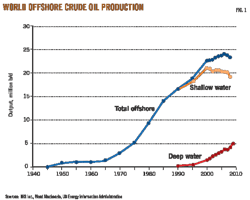An energy-assessment team for Saudi Aramco has systematically analyzed the interaction between process and utility systems at the company's Berri gas plant and identified realistic and achievable energy-saving opportunities for the plant.
This effort resulted in a number of energy-saving initiatives, which the team prioritized for implementation with a "road-map" strategy.
Long-term plan
As part of a long-term commitment by Saudi Aramco to energy conservation throughout its operating facilities, Saudi Aramco's Berri gas plant embarked on a strategic plan to improve energy efficiency. A complete energy assessment in 2006 yielded specific recommendations.
Nonetheless, changes in operating regime and different process and economic scenarios within the subsequent period prompted BGP to reexamine the energy assessment findings that were produced earlier. Hence in April 2008, BGP requested that Saudi Aramco's central energy engineering team, the energy systems unit, reevaluate BGP's energy efficiency performance.
Unlike the earlier studies, BGP had expressed interest in having the team focus only on its NGL-recovery facility, rather than on the entire plant. The NGL-recovery facility contributes significantly to the high energy consumption in the entire plant.
Since BGP involves close interaction between process and utility systems, it is imperative that the plant's utility system be incorporated in this study as a means accurately to quantify energy-saving opportunities from the NGL-recovery plant. The utility system consists of cogeneration, the sulfur plant's steam system, and associated steam system, together with the propane refrigeration system.
By focusing on a specific facility, plant engineers looked forward to seeing recommendations that could be implemented cost effectively.
The assessment or study phase is the most important aspect of any energy saving project. Its objective is simple and clear, i.e., to identify cost-effective energy saving opportunities while considering operability and safety in implementation. Meeting this objective required multidisciplinary technical support. In this case, several process and operation engineers from the Berri plant were involved in the study.
The screening process involved assessing the economic incentive of implementing such an initiative. It is important to note that the criterion used in economic incentive assessment is based on simple payback and the cost estimate used in this work is not rigorous but allows reasonable assessment effectively to identify or screen cost-effective energy saving opportunities. In addition, during screening, each initiative must also consider safety, operability, and constructability.
Process-utility interface
Before the value of energy saving can be estimated, understanding the process-utility interface concept is necessary.1
The process system normally consists of the heat exchanger network and separation and-or reactor systems. Nonetheless, the process requires, among other things, heating and cooling to function effectively. Most of the time this requirement is satisfied by the plant's utility system.
This system typically consists of cogeneration units (gas turbines with waste-heat recovery), boilers, steam turbines, letdown stations, desuperheaters, deaerators, condensate returns, and furnaces and cooling utilities (cooling water system, fin-fan coolers, and refrigeration system).
The utility system's one purpose is to provide the energy interface or link to the process. What is more important is that, because the utility system contributes significantly to the annual energy cost of the facility, this energy cost must be minimized cost effectively. This is in stark contrast to a popular belief that process energy savings can be easily calculated from a "given" utility cost (parameter) rather than from the "marginal" cost.
It is this marginal cost that takes into account the energy link between process and utility systems. Failure to establish this energy interface correctly leads to an inaccurate energy assessment and may pose serious economic implications for the project.1
The concept of marginal cost for the utility system is not new. It has been addressed by many in process integration.2 3 One of the potential reasons that the process utility interface is not given full attention is the failure to recognize the interdependent nature of the utility system itself.
A complex interaction exists in the individual utility hardware itself, let alone the interaction of the hardware with the process system. Thus, as in a process system that uses a process simulation tool to assess various interactions within it, we also need a simulation tool for the utility system.
Utility system models
Even though there are several commercial software packages available for the utility system, such as Visual Mesa, AspenUtil, and ProSteam,4 it was cost effective for Saudi Aramco to develop an in-house model, especially to take advantage of the benefits of the MS Excel-based spreadsheet.
The model performs simultaneous mass, heat, and power balances, as direct access to the steam properties databank is now possible within the spreadsheet. Detailed models of the individual utility equipment, such as steam turbines and boilers, can be easily incorporated.
The models also feature unit constraints, such as minimum and maximum capacities of the equipment, and fixed heating and power demand, which are critical for realistic modeling.1 More importantly, the availability of an optimization solver within the Excel-based spreadsheet allows the utility system optimization to be performed. Fig. 1 shows the typical configuration of the utility system.
Approach
In a typical energy assessment, we first focus on the process area to find energy-saving opportunities. This involves using a process simulation tool in conjunction with pinch analysis software.2
The amount of energy savings in each of the identified opportunities is then determined based on its energy value rather than on the cost. Typically, the units of the energy value are, among others, MMbtu/hr, Mw, and ton or pound of steam. At the same time, these opportunities are deliberated for any operability concerns, should these opportunities be implemented.
A separate assessment develops a utility model to reflect the existing performance of the utility system of the plant. Once this model is optimized to reflect the existing operating conditions of the utility system, the model can quantify the actual value of energy saving opportunities from the process.1
Based on the quantity of the energy savings determined from the process area, we then used this figure in our utility model as the amount of reduction in utility, i.e., the amount of utility generated from the utility system. In our case, the amount of steam reduction from the process, as a result of energy efficiency improvement, should be reflected in the utility model by modifying the steam balance of the system.
There are two serious negative implications if we implement the energy saving initiative immediately without using the utility model to account for this imbalance.1
First, we may end up of having this saved or "unused" steam to be vented off unnecessarily, making the actual value of the energy saving zero. Or we simply lose the opportunity to take advantage of the excess steam to generate more power from our steam turbines, provided that we have additional capacity to do so. This in essence reduces our demand for external power requirements, and hence an actual value of energy saving could have been realized.
Secondly, one may reduce the fuel consumption in the boiler to reflect the reduction in steam demand. Even though intuitively this is the logical thing to do, in many cases, this approach reduces the steam turbines' capacities to sustain their power generation. The worst part is that we have to resort to external power, which is relatively costly, to make up the loss of power generation from these turbines. This obviously defeats the purpose of the energy-saving initiative.
Hence, the clear advantage of having this utility model is that it allows us to maximize the actual value of energy saving in monetary form. The approach we adopted here was somewhat similar to the one used to determine the marginal utility cost.3 5 We instead use the utility model to link to the potential energy savings from the process, as we determined earlier in terms of either MMbtu/hr or ton of steam.
Since the savings from the process reflect the utility imbalance throughout the utility system, the utility model is then used to correct the imbalance, by optimizing the system, taking into account all physical and capacity constraints of the utility system.
Application
Here's a specific example of how the concept is applied to determine the actual value of energy savings in a condensate stripper system of Berri's NGL-recovery plant.
Fig. 2 shows the processing area covering the condensate strippers (C1 and C201) and the associated heat exchangers surrounding these strippers. The liquid feeds, which are predominantly hydrocarbon liquids recovered from the slug catchers, have to be stripped to remove any light hydrocarbons until the liquid outlet streams achieve specifications as NGL products (stabilized NGL).
Currently, the existing heat exchangers, involving feed preheating and product rundown cooling, use steam and air cooling, respectively. As such, a potential heat recovery between feed preheating and product rundown could provide an opportunity to reduce energy consumption in this area.
The composite curve of the condensate stripper areas shows an opportunity to eliminate cold utility requirement from the process (Fig. 3).
Pinch analysis identified the scope for heat recovery for the entire condensate stripper area. Fig. 3 shows a relevant composite curve from pinch analysis software6 that demonstrates that the condensate stripper area requires only a minimum hot utility of 6 Mw and no cold utility.
To achieve the target of 6 Mw, two possible heat-recovery opportunities can be identified from C1 and C201, respectively. Fig. 4 shows the schematic of these two opportunities that highlights the heat recovery between the NGL product rundown and the preheating within C1 and C201, respectively. Furthermore, the illustration highlights new pipe work and heat exchanger requirements.
Based on the proposed opportunities, the 60-lb steam savings are estimated to be 4,000 lb/hr and 28,000 lb/hr for E16 and E201, respectively. The savings, quoted in terms of pounds of steam use, are then to be quantified in monetary terms using the rigorous in-house utility modeling tools.
These energy savings were determined to be worth $830,000/year in E201 unit and $133,000/year in E16 unit. Eliminating air cooler E203 led to electricity savings valued around $30,000/year. Thus the total energy saving at C201 area alone is around $860,000/year.
While this task is being performed, the team deliberated the pros and cons of the proposed opportunities. The operation engineer stressed that stripper C1 is not normally used, as the incoming feeds to C1 are normally in a batch form.
In a year, the frequency of using C1 stripper is rather small, and based on this argument the team decided to focus on the stripper C201 area instead, where exchanger E201 consumes significant amounts of steam. In addition, the team briefly assessed the pipe work requirement from the site layout perspective, together with the potential hydraulic requirement.
The cost estimate for the new heat exchanger NEWHXB (for stripper C201 area; Fig. 4) was determined. The cost did not include the piping cost, as the heat exchanger cost is used here to screen the energy saving initiative. If the initiative is selected for detail design assessment, the piping cost, together with any hydraulic requirement, will obviously be included.
Implementation guidelines
The study identified 21 energy saving opportunities, of which 13 met the technical and economic criteria. Two classes of energy saving implementation plan were developed, operational improvement, involving practically zero investment, and capital cost initiatives.
These initiatives are prioritized according to a strategic energy saving "road map" (Fig. 5) to assist the Berri plant in implementing the recommended initiatives. Logically, the low risk and no cost projects should be carried out first, followed by the capital cost project.
About 60% of the total energy savings is attributed to operational improvement alone. This should provide an incentive for the Berri plant to focus immediately on operational improvement to achieve an immediate impact on the plant's energy saving initiatives. As demonstrated in this study, the Berri plant's utility system offers huge opportunities for energy conservation, especially through minimizing venting steam (Initiative 1).
As for the capital investment opportunities, the overall project was estimated to give a simple payback of less than a year. Since this showed promising economics, the team recommended that preliminary detail engineering work be initiated at the same time that the plant focuses its attention on operational improvement initiatives.
Status
The Berri gas plant is currently pursuing the initiatives with formation of an in-house energy-saving task force whose purpose is to coordinate the implementation plan within the plant. The task force team has given the operational improvement initiatives the highest priority for implementation. As such, detail discussion with the central engineering team is under way to implement some of the operational improvement initiatives. ✦
References
1. Amminudin, K.A., Mana, M. Al-Owaidh, and Zaher, S. Barri, "Process-utility interaction Analysis for a True Energy Saving Value Determination," AIChE Spring Meeting, Apr. 26-30, 2009, Tampa.
2. Kemp, I.C., Pinch Analysis and Process Integration—A User Guide on Process Integration for the Efficient Use of Energy, 2nd Edition, Rugby, UK: IChemE, 2007.
3. Smith, R., Chemical Process Design and Integration, Chichester, UK: John Wiley & Sons Ltd., 2005.
4. Eastwood, A., "ProSteam—A Structured Approach to Steam System Improvement," Steam Digest 2002, compiled for the Industrial Technology Program, US Department of Energy, Energy Efficiency and Renewable Energy, pp. 59-68.
5. Kumana, J.D., "Use Spreadsheet-Based CHP models to Identify and Evaluate Energy Cost reduction Opportunities in Industrial Plants," 23rd IETC, Houston, May 2-3, 2001.
6. SPRINT software, Centre for Process Integration, University of Manchester, Manchester, UK.
The authors
Abdulaziz A. Najjar is currently a process engineer with the Shedgum gas plant. He was previously with the energy systems unit of process and control systems department, Saudi Aramco.
Ibrahim S. Dossary is a process engineer at the Berri gas plant, Saudi Aramco.
More Oil & Gas Journal Current Issue Articles
More Oil & Gas Journal Archives Issue Articles









